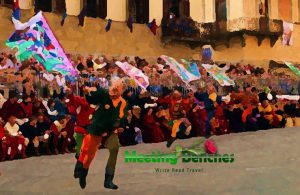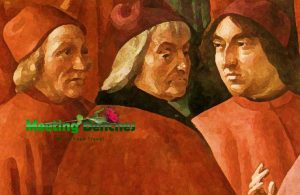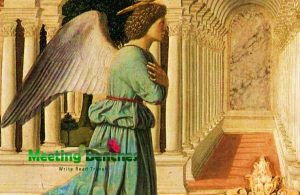





Our Italian Renaissance Travel starts from Montepulciano, a small town on a hill 600 meters above sea level. http://www.montepulciano.net/ Famous for its name, the Tower of its Renaissance Palace gives you the opportunity to stare at the green Tuscan hills. Outside of its walls you can enter the Church of Sant’Agnese and visit the Medici Fortress, accessing the historic center from Porta di Gracciano. The De’ Ricci cellar (where Montepulciano wine is preserved), https://www.cantinadericci.it/ occupies the basements of this palace and is considered one of the most scenic wineries in the city.

A prodigy boy of his time, is considered to be the leading humanist of the fifteenth century in Italy. ANGELO POLIZIANO was destined for even greater literary glory, but the scythe of death had bred his life at the age of forty years. Born in Montepulciano in 1454 and raised at the Medici Court in Florence, he was one of the leading poets of Italian humanity. He wrote a lot, and his production also includes an unfinished poem (the Rooms for the Giostra) dedicated to Giuliano de’ Medici).

In Perugia, the polyptych for the Franciscan monks of Sant’Antonio is what you can admire at the National Gallery of Umbria. Entering this museum, you will discover a wonderful painting where PIERO DELLA FRANCESCA manages to overcome the limitations of the gold fund set by its buyers. Leaving room for his genius, he made sure that the beautiful scenes of the predella could remain in the memories of any visitor.
Do not forget that Perugia, http://turismo.comune.perugia.it/ offers you festivals and events. The National Gallery of Umbria, http://www.artiumbria.beniculturali.it/index.php?it/181/galleria-nazionale-umbria is a museum housed inside the Priori palace, hosting works by Perugino, the Pinturicchio and a rich collection of Renaissance masterpieces. It is the richest collection of art in Umbria, providing you with a fascinating insight into art from the Middle Ages to the nineteenth-century neoclassical period.
This choral group is distinguished in the Umbrian and national choral landscape, receiving many appreciations for the fusion of the voices, the accuracy of the interpretations and the musical projects it proposes. Their repertoire ranges from ancient sacred to modern. The Libercantus Ensemble http://www.libercantus.it/ is a vocal group of music founded in Perugia in 2006, with the project of rediscovering the 14th century polyphonics kept at the Augusta Biblioteca in Perugia.
Arriving in Arezzo, http://www.arezzoturismo.it/php/ you will discover that the Roman amphitheater is between Crispi and Via Margaritone. It was built with sandstone and brickwork and contained 8,000 people. On a part of the Amphitheater, a convent was built (today Archaeological Museum founded in 1822 by the Fraternity of the Laity). Among the other works of art preserved in the Cathedral of the city, do not forget to admire the Maddalena by Piero della Francesca. At the end of the left nave, the tomb of Bishop Guido Tarlati, which was built in 1300, awaits you.
PIERO DELLA FRANCESCA had accepted in 1452 the task of continuing the work in the apsidal chapel of the church of San Francesco. In Arezzo, the stories of the True Cross (frescoed in three overlapping registers on the high walls), they will occupy it in a first phase until the late 1950s.
The Timeless Restaurant is in Monterchi (Hospital Street, 18th in the center), is next to the entrance where Madonna del Parto is housed. Entering, you will find young people dedicated to the hall and wine, people who prepare succulent dishes, very well done, with an interesting menu made of homemade pasta, chianina sauces, ravioli and other stuffed pasta with truffles. Good fassona meat (well cooked, tasty and succulent).
PIERO DELLA FRANCESCA was born around 1415 in San Sepolcro. His father was a leather merchant, his mother was originally from the nearby village of Monterchi. Being his father dead before he was born, he was known to the matronimic (his mother was known as “Francesca” as married to the Francis). His fellow citizens had commissioned him the Polytic of Mercy (visible in the local Civic Museum) to which he will work until 1462.
In 1454 another commission had come to PIERO DELLA FRANCESCA from his fellow citizens, the execution of the polyptych destined for the Augustinian church. Missing the Madonna and Child Center, the side panels, are now divided between different museums (Lisbon, London, New York, Milan), while some elements of the predella are divided between Washington and the Frick collection in New York. Observing his Resurrection (in the Conservatory Room of Sansepolcro’s Residence), writer Aldous Huxley had claimed that it was the most beautiful painting in the world. http://www.guidaturisticaurbino.it/
In Urbino, PIERO DELLA FRANCESCA he intensified intense relations with Duke Federigo del Montefeltro, for which he completed some of his most famous works: the dictator with portraits of the dukes, Federigo and his wife Battista Sforza (what you can see in Florence, in the Uffizi Gallery), and the famous Flagellazione (Urbino, National Gallery of Umbria). In these paintings of extreme maturity, you can find the same beauty as the Madonna of Senigallia (Urbino, National Gallery of Umbria).
From the 14th century, this church of Rimini http://www.rimini-it.it/malatesta/tempio-malatestariminus.htm was chosen by the lords of the city, Malatesta as a place for their burial. Under this tradition, Sigismondo Pandolfo Malatesta decided to build a great chapel of gentility, on which he began to work in 1447. The Isotta of the Acts, lover and then married to Sigismondo, obtained from the Pontiff permission to expand and use the adjacent chapel. The wall works of both of them were finished in the spring of 1449. Dated 1451 is the fresco by PIERO DELLA FRANCESCA depicting Sigismondo Pandolfo Malatesta in adoration of San Sigismondo, inside the Malatestian Temple of Rimini, renovated in Renaissance forms by Leon Battista Alberti.
She was born in Florence, and who reads her texts senses the search for taste, because in narrative intrigue she skillfully replaces a plot of motifs similar to musical sequences. His great literary theme was that of woman’s solitude, seeking for a dignity in the world of men. That unique daughter of a Sicilian family had been encouraged by her father to undertake humanistic studies. ANNA BANTI, has been involved in art criticism, especialistic narrative, with a script created a rich and refined prose.
An open-air museum. This is Florence. http://www.firenzeturismo.it/en/ Its historical center encloses such a wealth of masterpieces that it is difficult to separate the city from its works. It was inserted by UNESCO among the human heritage. You too, walking through the Roman quadrilateral (in the Piazza della Repubblica) and in the streets of the medieval city, up to the splendor of Palazzo Pitti and the transformations of Florence’s capital, you can look through the whole history of the city. Do not forget to go to the Uffizi Gallery where you can see the paintings of two special brides (Federico da Montefeltro and Battista Sforza), made by Piero della Francesca around 1472.
In Florence, if you are looking for a romantic hotel you can go to the Hotel Brunelleschi, https://www.hotelbrunelleschi.it/ special site able to satisfy your desires. Located in the historic center of the city, within this city center hotel, you will breathe an inebriating atmosphere. Book a hotel room for your weekend, savoring the romantic charm of these places, near the Uffizi, close to Ponte Vecchio and Palazzo Strozzi, without forgetting to walk into the cobbled shopping streets, where to eat your wonderful florentine steak, brining with good red wine from the Chianti hills.
The intellectual property of the images that appear in this blog correspond to their authors. The sole purpose of this site, is to spread the knowledge of these artists and that other people enjoy their works. To pursue this issue, you can digit: http://meetingbenches.com/2017/09/italian-renaissance-landscapes-horizons-piero-della-francesca/
An invitation to rediscover the world with eyes full of wonder Spring, a symbol of…
Australian Aboriginal and ancestral spirits who created the world "Leaving bitterness behind is a journey…
Poetry and Culture of the French Pacific Islands You’re intrigued by the idea of an…
A Journey Where Wisdom Comes from Listening, Not Speaking The Indigenous Peoples of North America…
Passion and Tragedy in Shakespeare's Verona The desire to escape from the everyday and take…
Provence Trip, Inspiration for All Beauty Lovers "Sometimes you leave to forget, other times to…
This website uses cookies.